Tea in December
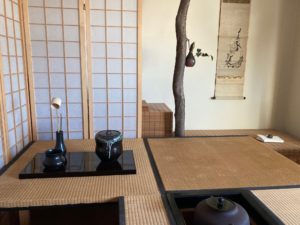
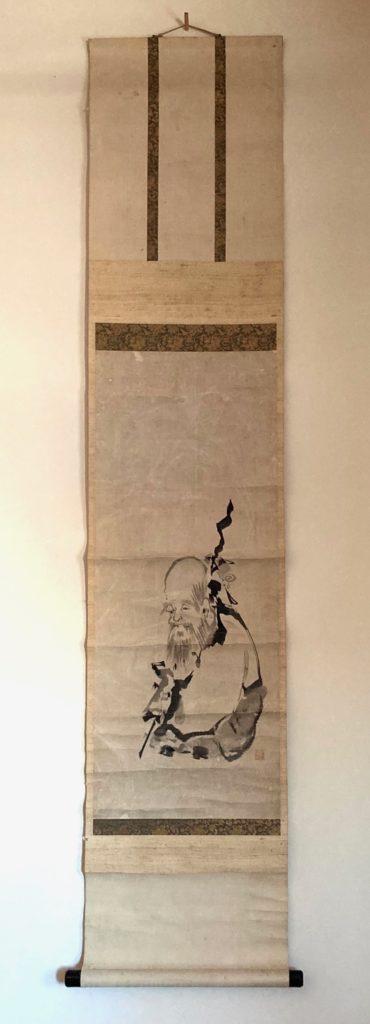
Kake-mono, 掛物, hang-thing, ink drawing of Fuku-roku-ju, 福禄寿, Fortune-prosperity-longevity; L. 5.5 shaku kane-jaku.
Fuku-roku-ju, 福禄寿, Fortune-prosperity-longevity, is one of the Shichi-fuku-jin, 七福神, Seven-fortune-gods, who bring happiness and fortune, especially during the New Year. In China, it is believed that he was added to the group to bring the lucky number 7.
Fukurokuju was a Taoist scholar, and is depicted as a bearded dwarf with a high head full of knowledge, and who carries a staff with a scroll that contains all the wisdom of the world.
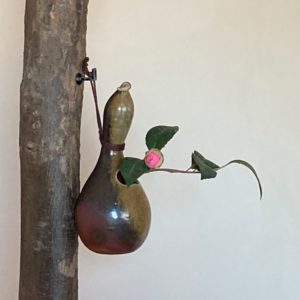
The opening in the side of the vase is a highly stylized gourd. Multiple gourds are auspicious motifs. The toko-bashira, 床柱, floor-post, is made of katsura, 桂, cinnamon bark-tree. It is said that the markings on the moon depict a hare making mochi beneath a katsura tree, that the Chinese believe is the height of 500 jō.
At times, Hotei is depicted carrying a hyōtan. Natural dried bottle gourds have been used as vessels for water and other liquids. Gourds of other shapes have also been used as containers for millennia. Other readings for the Kanji hyō, 瓢, are hisago and fukube. Rikyū used a fukube as a sumi-tori, 炭斗, charcoal-measure, with the ro.
In Buddhism, the hyōtan as a symbol is gen-gen, 玄々, mystery-mystery. In Taoism, the two-chamber bottle gourd represents a container for water, 瓢, gourd, and a container for rice/food, 箪, rice basket, which provides all that is needed to live a simple life of humility.
It is believed that the islands of Japan are supported on the back of an enormous namazu, 鯰, catfish; fresh water catfish, Silurus asotus. It is this mythical creature that causes earthquakes, and can be calmed by holding an equally huge hyōtan filled with sake.
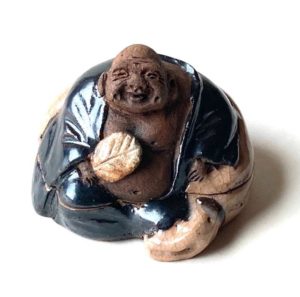
Hotei is one of the Shichi-fuku-jin, 七福神, Seven-fortune-gods. His enormous bag is filled with myriad treasures. He often is depicted holding an uchiwa, 団扇, round-fan. In the Jū-gyū-zu, 十牛図, Ten-ox-pictures, that detail the human pursuit of Buddhist enlightenment, Hotei is variously depicted in the final picture, talking with another person, holding a walking staff, and a container to have filled with sake when he gets to town. Things appear to have returned to normal. Perhaps.
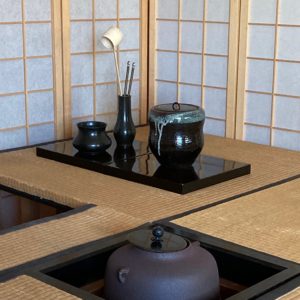
The improvised ‘naga–ita’, 長板, long-board, is composed of two black-lacquered trays, each measuring 8.8 sun kujira-jaku square. The black-lacquered ‘board’ is to protect the tatami, as a portable fu-ro, 風炉, wind-hearth, may also be displayed on it. The black-lacquered wooden ro-buchi, 炉縁, hearth-frame, serves the same purpose of protecting the surrounding tatami from the heat of the fire in the sunken hearth.
The measurement of each tray is 8.8 sun kujira-jaku, that is written with the Kanji, 八十八, and read hachi-jū-hachi. These numbers can be written to form the Kanji for kome, 米, rice, and the Kanji is symbolic of Infinity in Space.
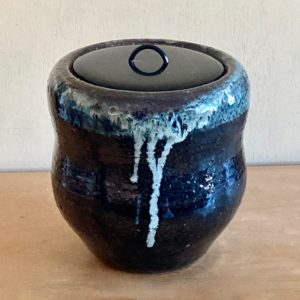
Mizu-sashi, 水指, water-indicate, with the silhouette of a gun-bai, 軍配, force-distribute, gourd-shape battle fan, are also used by Sumo referees. The gourd reference is an inverted hyō-tan, 瓢箪, gourd-basket, and is achieved by changing the order of the Kanji to tan-pyō, 箪瓢, basket-gourd. Hotei is depicted holding a gunbai.
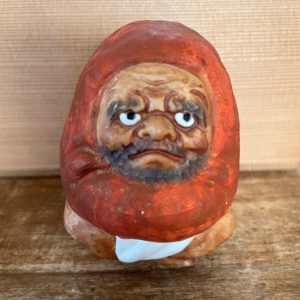
In Buddhism, the figure of Daruma is often depicted in the form of gourd, having lost the use of his legs during nine years of meditation. There are gourd-shaped Daruma roly-poly dolls that always upright themselves. Also in Buddhism, a tan-pyō, 単票, single-label, is a name tag placed above where one would sit in a Zen-dō, 禅堂, Meditation-hall. Likening a meditating Daruma to a hyōtan, and turning it upside down, would result in a tanpyō, inverted gourd, which is brought into the Zendō as a place-card.
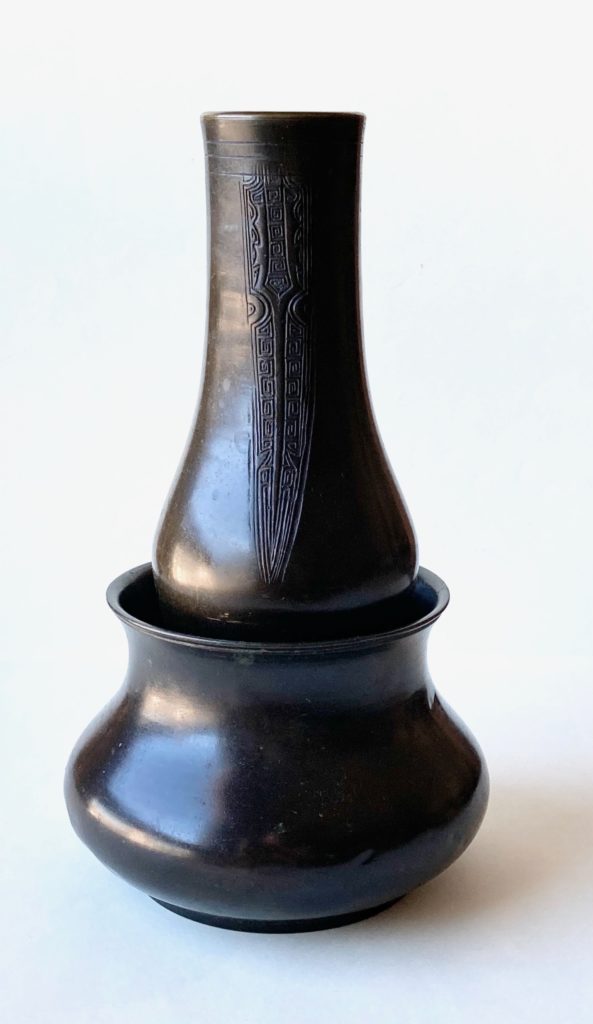
A bronze shakutate set on top of a bronze e-fugo, 餌畚, feed-pouch, ken-sui, 建水, build-water, that may suggest that the origin of both utensils was a hyō-tan, 瓢箪, gourd-basket, bottle gourd. The bottle gourd is one of the most sacred symbols of Taoism, and a powerful symbol in Buddhism.
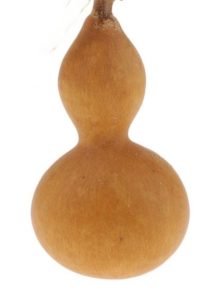
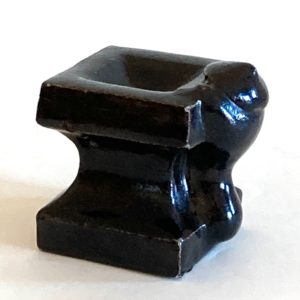
The futaoki, was inspired by a Chinese incense burner in the form of a i-do, 井戸, well-door, with a figure looking over the top. This was one of seven objects Rikyū chose to use as his nana-shū futa–oki, 七種蓋置, seven-types lid-place. An aspect of the imagery is that the person is an enlightened monk who stays by the well as a guardian so that children will not fall into it. Chinese imagery often depicts children playing in gardens, near wells, and turning over fish bowls. As an incense burner, the ‘well’ symbolically provides water for protection. The form of the monk resembles an inverted bottle gourd, suggesting the reverse of hyōtan to tan-pyō.
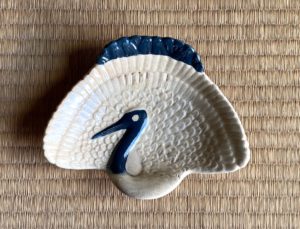
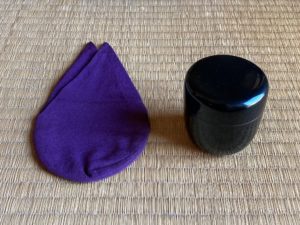
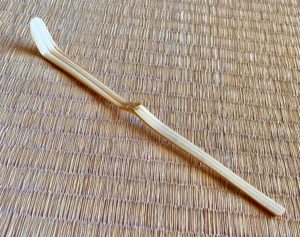
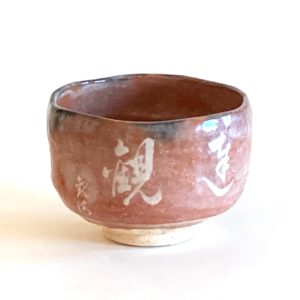
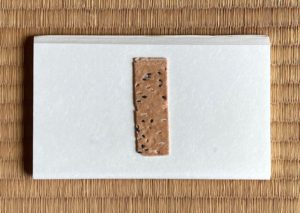
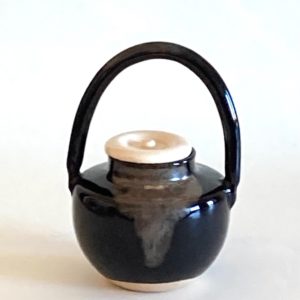
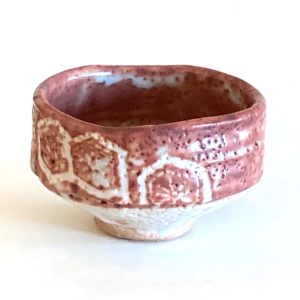
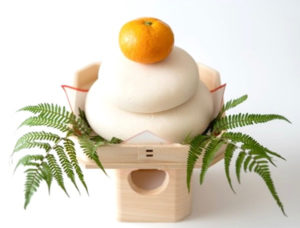
An important event in the 12 month in preparation for the New Year in the traditional Japanese arts is koto-hajime, 事始め, matter-begin. At this time, kagami mochi, 鏡餅, mirror mochi, is offered by each student or group of students to their teacher, sen-sei, 先生, before-live, in the world of gei-sha, 芸者, art-ist, and mai-ko, 舞子, dance-child, and Chanoyu.
The 12th month is filled with many activities in preparation for the New Year, which found in the old name for the month is Shi-wasu, 師走, Master-run. It is such a busy time that even the teachers, sensei are running around. Because of similar aspects of the Kanji shi, 師, master, and the Kanji shi, 獅, lion, there may be a remote possibility that there is some connection. Not with lion, but with inoshishi, 猪, boar, and not the Kanji, but the sound of the word shi. Inoshishi is the last of the 12 Asian zodiac signs, and Shiwasu is the name of the last of the 12 months. There is a bit of a catch, as even now, shishi might also refer to deer meat, and the Japanese for deer is shika, 鹿. Shika is also read roku, as in the name, Roku-on-ji, 鹿苑寺, Deer-park-temple, the official name of the Kin-kaku-ji, 金閣寺, Gold-pavilion-temple, in Kyōto. Deer Park was a place in India where the Buddha preached.
In ancient times shishi referred to meat from an animal that was eaten, so the words i no shishi meant boar meat. It is curious to note that the picture in the Japanese koyomi for December depicts an interior with a cooking pot over a fire in the hearth, with a mountainous winter scene through window. It is possible that there is a bo-tan nabe, 牡丹鍋, male-red pot, cooking in the pot, as it is the time of the year for such a nourishing food. Bo-tan, 牡丹, tree peony, is the poetic name for boar meat.
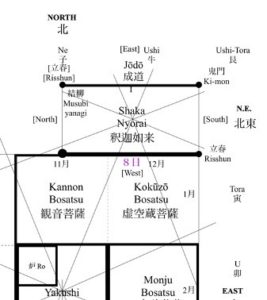
The ideal location of the tokonoma in a yo-jō-han, 四畳半, four-mat-half, Tearoom, is in the north wall toward the east. The name for the northeast direction is the ki-mon, 鬼門, demon-gate, is, which is the source of harsh weather that is identified as a demon, oni, 鬼. However, it is possible that the ‘demon’ is actually the protector from the harsh weather. Fearsome looking human-like beings are guardians, especially, the Ni-ō, 仁王門, Benevolent-kings, who are also identified with Buddhist temple gates, Ni-ō-mon, 仁王門, Benevolent-kings-gate. It is curious that the word demon, oni, is the reverse of niō, for the guardian kings. The kings represent the In, 陰, receptive, and Yō, 陽, penetrative, aspects of Dai-nichi Nyo-rai, 大日如来, Great-sun Like-become, the universe made manifest. Dainichi is also the guardian of the southwest, and in the yo-jō-han, 四畳半, four-mat-half, Tearoom, is identified with the host’s entrance, cha-dō guchi, 茶道口, tea-way opening. Another beneficent ‘demon’ is Fudō Myō-ō, 不動明王, No-move Bright-king, who is also a manifestation of Dainichi.
Some ‘demons’ are depicted holding the vajra, kon-gō, 金剛, gold-strong, the lightning bolt of Buddhist wisdom and indestructible truth wielded by Indra, Tai-shaku-ten, 帝釈天, Emperor-explain-heaven (deva), and many other deities. Among these deities are the Niō, also called Kon-gō Riki-shi, 金剛力士, Gold-strength Strong-man, who wield the vajra, lightning bolt.
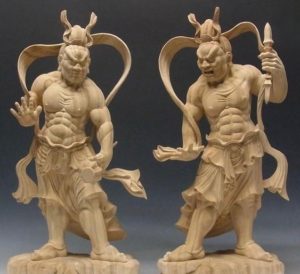
The guardian statues, dated 711, are located at the Chū-mon, 中門, Middle-gate. In the ro-ji, 露地, dew-ground, garden of the Teahouse, there is the chūmon, which separates the physical outer world, and the spiritual inner world of the Tearoom. The gateway can be a simple hinged door supported between two posts, the hinge being closed, and the opening made by the opened gate. The Niō?
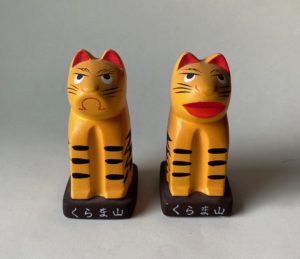
The origin of the Niō is with one of the earliest deities who guard the Buddha, Vajra-paṇi, thunder-hand, who is known in Japan as Kongō Rikishi. He is depicted as a fearful human-like being with his open mouth. In time, Vajrapani became two deities, the Niō, who are manifestations of the In and Yō principles. One with his mouth open on the right of an entrance, named Na-ra-en, 那羅延, What-spread-stretch, open mouth, and one on the left named and Mi-sshaku, 密迹金剛, Secret-mark, with closed mouth. Naraen, with open mouth pronounces “Ah”, the first letter of the Sanskrit alphabet, and Misshaku with closed mouth pronounces “Un”, the final letter. The two combine to express the mantra of existence “Om”.
Perhaps the Niō have influence on the Tearoom, with ‘open’ on the right and the open alcove of the tokonoma, and ‘closed’ on the left in front of the teishu and the Tea utensils facing a blank wall, as in Zen.
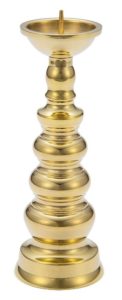
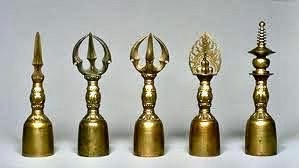
Rō-shoku-dai, 蝋燭台, wax-lamp-support, (pricket) candlestick, brass. Five types of kon-gō-rei, 金剛鈴, gold-strength-bell.
During a Tea presentation that is part of a sacred ritual, there may be displayed in the tokonoma a centered kōro, with a candlestick on the right and a flower vase on the left. There is a resemblance between the vajra and the pricket candlestick of a buddhist altar. The pair of brass oil lamp stands are based on the single blade vajra, with lotus motifs. Other styles have a pricket to hold a candle. The single brass candlestick is a standard design with a pricket for the candle. It should be remembered that the vajra represents lightning.
Perhaps the lightning bolt vajra in the form of a candlestick represents the vajra held by the Buddhist guardian ‘demon’ of the Kimon.
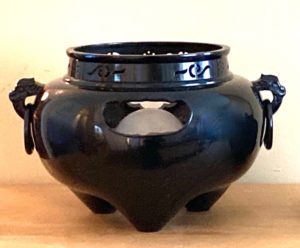
One of the earliest portable metal braziers in Chanoyu is the ki-men bu-ro, 鬼面風炉, demon-face wind-hearth, which has on the sides ‘demon’ masks with rings in their mouths. These are protective beings guarding the fire in the hearth. These are the same faces or masks that are present on the ancient iron kama, 釜, kettles, that need removable rings to move them.
The tokonoma of a yojōhan Tearoom is located on the north wall toward the east, regardless of the room’s physical orientation, rather like a map with north at the top. This direction is identified with the 12 Asian zodiac signs of Ushi, 丑, Ox, and Tora, 寅年, Tiger. Together they are called Ushi–Tora, Gon, 艮, which is a sign of the Eki-kyō, 易経, Change-sutra, meaning calmness.
Ko-kū-zō Bo-satsu, 虚空蔵菩薩, Empty-void-keep Grass-buddha, guardian of the zodiac signs of the Ushi, 丑, Ox, and Tora, 寅, Tiger. The Ox is identified with the 12th month, and the Tiger is identified with the 1st month, and are identified with the northeast direction. These two signs together are collectively called Ushi-Tora, which is given the Kanji, Gon, 艮, Stopping. The northeast is called the ki-mon, 鬼門, Demon-gate. Therefore, Kokūzō Bodhisattva of Ushi-Tora is often said to be the Buddhist deity who wards off demons.
Kokūzō is the Japanese name for the Sanskrit Akasa-garbha, space-chamber. The word garbha is the same word for Ksiti-garbha, earth chamber, who is Jizō in Japanese.
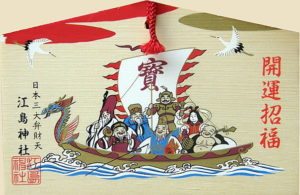
Depicted in the ema, the happy gods are sailing in the Takara-bune, 宝船, Treasure-boat, that has a dragon head sen-shu-zō, 船首像, ship-neck-figure. Ryū-kotsu, 竜骨, dragon-bone, keel of a boat. The square sail is emblazoned with the Kanji takara, 宝, treasure. Above the boat are a pair of tsuru, 鶴千, cranes, that believed to live a thousand years. Pictured above, printed in red is the familiar New Year felicitation motto, Kai-un Shō-fuku, 開運招福, Open-luck Beckon-fortune. The ema is from E-no-shima Jin-ja, 江島神社, Inlet-’s-island God-shrine.
Printed on the left side of the ema is Ni-hon San-dai-ben-zai-ten, 日本三大弁財天, Sun-rise Three-great-distinguish-wealth- heaven (deva). Benzaiten is the only female of the group, and has her origins in the Hindu deity, Saraswathi, the goddess of music, eloquence, also wealth and water; her emblem is the bi-wa, 琵琶, lute. Benten’s shrines are often on islands, one of great importance is Itsukushima Jinja.
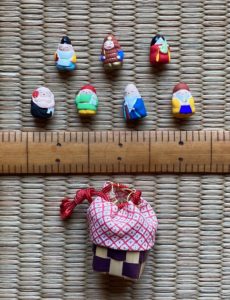
Group of tiny, mame, 豆, bean(-size), painted, ceramic dolls of the Shichi-fuku-jin, 七福神, Seven-fortune-gods. Mono-sashi, 物差し, thing-distinction, ruler, kane–jaku, 曲尺, bend-span. Bamboo basket container.
The Shichi-fuku-jin, 七福神, Seven-fortune-gods: pictured from the top left:
E-bi-su, 恵比寿, Bless-like-longevity, Bi-sha-mon-ten, 毘沙門天, Help-sand-gate-heaven, Ben-ten, 弁天, Distinguish-heaven, Ho-tei, 布袋, Cloth-bag, Dai-koku, 大黒, Great-black, Fuku-roku-ju, 福禄寿, Fortune-stipend-longevity, Ju-rō-jin, 寿老人, longevity-old man-person. The gods live on the island of Hō-rai, 蓬莱, Mugwort-goosefoot.
Ceramic figure of Dai-koku, 大黒, Great-black, the god of rice and fertility, is one of the Shichi-fuku-jin, 七福神, Seven-fortune. He is depicted holding a ko-zuchi, 小槌, hammer, and standing on two kome-dawara, 米俵, rice-bales. Salvaged from the ashes of a sacred fire.
Daikoku’s name, 大黒, may also be read ō-guro, which was the name given by Rikyū to a kuro Raku chawan, 黒樂茶碗, black Pleasure tea-bowl, made by Chō-ji-rō, 長次郎, Long-next-son.
The word koku may be written with the Kanji, 石, stone, which is a traditional unit of volume, approximately 180.4 liters, and was applied to quantities of rice. This seems appropriate for Daikoku, the god of rice, and there are countless figures of Daikoku carved from stone.
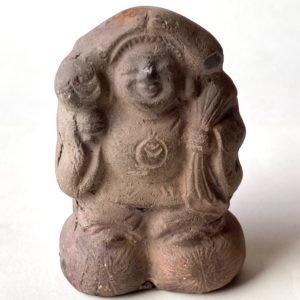
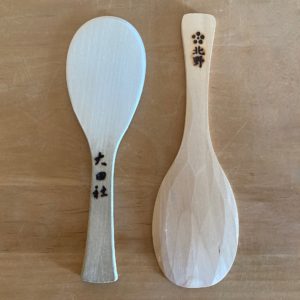
Meshi jaku-shi, 飯杓子, (cooked) rice scoop-of, also called sha-mo-ji, 杓文字, ladle-letter-character. Said to be derived from the first part of shaku-shi, 杓子, ladle-of, plus mo-ji, 文字, letter-character.
Left: sha-mo-ji, 杓文字, ladle-letter-character, wood, stamped Ō-ta-sha, 太田社, Great-field-shrine; L. 6.8 sun kane-jaku, from an ancient Shintō shrine in Kyōto. Right: sha-mo-ji, 杓文字, ladle-letter-character, wood, stamped Kita-no, 北野, North-field, with ume no hana, 梅の花, prunus’s flower; L. 7 sun kane-jaku, from the Kita-no Ten-man-gū, 北野天満宮, North-field Heaven-full-palace, shrine in Kyōto.
The profile of the shamoji may suggest the outline of Daikoku’s great bag of treasures, as he is the god of rice.
In the 18th century, on Miya-jima, 宮島, Shrine-island, a monk of Dai-gan-ji, 大願寺, Great-vow-temple, where Benten is worshipped, sold rice scoops, sha-mo-ji, 杓文字, ladle-letter-character, in the shape of Benten’s bi-wa, 琵琶, strum-lute, as souvenirs to those visiting Itsuku-shima Jin-ja, 厳島神社, Strick-island God-shrine. Benten is one of the Shichi Fuku Jin. During a Cha-ji, a shamoji is used to serve rice. The shamoji is made of a wide variety of woods, but the standard length is 7 sun kane-jaku. Shintō shrines have shamoji available that are marked with the name or motif associated with the shrine.
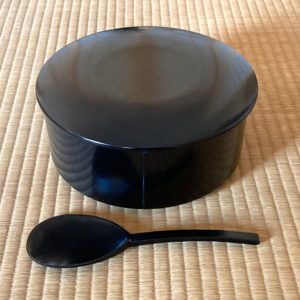
The number 8 is extremely symbolic significance of the Infinity in Space. The number 6 is symbolic of Infinity in Time. It may seem curious that the hanki measurements are in kane-jaku, and the shamoji measurement is in kujira-jaku, however having both measurement devices combine Infinity in Time and Space.
The length of the scoop is 6 sun kujira-jaku. The length of the oval scoop end is 2.64 sun kujira-jaku – the length of the handle is 3.3 sun kujira-jaku. The measurement of 2.64 transposed from kujira-jaku to kane-jaku is 3.3 sun kane-jaku. The relationship between the two lengths is 8 to 10, which is a manifestation of the concept of yata, 八咫, eight-span, as present in the sacred Shintō Ya-ta Kagami, 八咫鏡, eight-span mirror.
The construction of the hanki is customarily made of bent cedar wood that has a seam, toji-me, 綴じ目, bind-eye. The seam establishes the shō-men, 正面, true-face, and because it is in two parts, right and left, it manifests the aspect of In, 陰, negative.
Ō-miso-ka, 大晦日, Great-dark-day, New Year’s Eve. ‘Misoka’ is the last day of each month.
Jo-ya gama, 除夜釜, Exclude-evening kettle, the last Tea presentation of the year that is usually held on New Year’s Eve. Prior to the Tea presentation, one might eat a bowl of toshi-koshi so-ba, 年越し蕎麦, year-surpass buckwheat-wheat, buckwheat noodles in a savory broth. Noodles should be as long as possible, as they are symbolic of longevity. Buckwheat has been a part of the Japanese diet for over 10,000 years. An imperial edict issued in Nara in 722 advised on the planting of buckwheat.
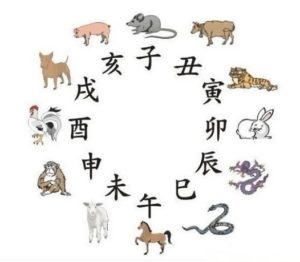
The Jū-ni-shi, 十二支, Ten-two-branches, are 12 animals in the Asian zodiac, which have Kanji that are different from the animal. Each animal sign is modified by one of the dual aspects of one of the Five Elements, Go-gyō, 五行, Five-transitions, in a system called E-to, 干支, Stem-branch. The physical elements are divided into dual aspects of older, e, 干, and younger, to, 支, and each of which is given a particular Kanji: Mizu-no-e, 水の干, and is contracted as the Kanji Mizunoe, 壬. When associated with one of the zodiac animal signs such a Tora, 寅, Tiger, it is written as Mizunoe–Tora, 壬寅, Water’s-elder brother Tiger. To make things more elaborate, the Kanji 壬寅 are also read Jin-in. The 2022 was a Jinin, Water’s elder brother Tiger.
The 12 zodiac animals combined with 10 dual aspects of the 5 elements creates a cycle of 60 signs, called a sexagenary cycle. Adopted from China, the 60 signs cycle has been used in Japan for centuries and has also been used to designate years and days.
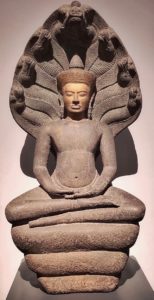
Before his enlightenment, satori, 悟り, when he became the Buddha, Shaka sat beneath a tree facing east. After 4 weeks it began to rain, and Mucalinda, the great cobra, emerged from the earth, and coiled his body three times to form a cushion for Shaka, and sheltered him with his seven heads. After a total of 49 days of meditation, Shaka attained enlightenment – Jō-dō-e, 成道会, Become-way-meeting. The symbolism of Mucalinda’s seven heads is that they represent the Sun, the Moon and five planets, which is in accord with the 7-day periods of Shaka’s meditation. The origin of the 7-day week is debated among scholars, but may have begun in ancient India.
On the 8th day of the 12th month according to the lunar calendar, the Buddha (563? to 483? B.C) attained satori, 悟り, enlightenment, which is celebrated in Japan as Jō-dō-e, 成道会, Become-way-meeting. As a youth, his name was Gautama, and was a member of the clan of Sakya, Sha-ka, 釈迦, Explanation-(sound). He renounced his princely life of ease and plenty, and left home at the age of 20, and became an ascetic. After punishing self-denial, he sat in meditation beneath a tree for 49 days (7×7), and on the morning of the 8th day of the 12th month, he saw the rising of Morning Star, Venus, Myō-jō, 明星, Bright-star, and became enlightened. He was 35. Sujata, a farmer’s wife, brought the Buddha a bowl of kheer, a sweetened soup of milk and rice, a staple in Indian diet.
The Buddha continued to sit after his enlightenment, meditating beneath the tree, and then standing beside it for a number of ‘weeks’. The tree is called the Bodhi tree, bo-dai-ju, 菩提樹, grass-hold-tree, and is variously identified as sacred fig, Ficus religiosa, or Tilia miqueliana, a species of linden tree. During the fifth or sixth ‘week’, he was beset by heavy rains while meditating but was protected by the hood of the serpent king Mucalinda. Seven ‘weeks’ after his enlightenment, he left his seat under the tree, and decided to teach others what he had learned, encouraging people to follow a path he called the ‘Middle Way’.
The Buddha sat for seven ‘weeks’ before and seven ‘weeks’ after his enlightenment, which is a total of 98 days. Including the day of his enlightenment makes a total of 99 days. There was a 99 foot tall statue of Buddha built in 2015 in Drakgo, Tibet, until it was destroyed by the Chinese in 2021. There is a deck of 99 cards called ‘Quotes of Wisdom’ containing the sayings of the Buddha. The age of 99 is called Haku-ju, 白寿, White-longevity, which is derived from removing the top line of the Kanji, hyaku, 百, hundred, that results in the Kanji for white.
There is an ancient legend that surrounds the number 99. Tsukumo-gami, 九十九神, Nine-ten-nine gods, 99 is written, 九十九, and is also read ku-jū-ku, but somehow is read tsukumo. The word tsukumo also refers to tsuku-mo gami, 付喪神, attach-mourning god, which refers to the belief that tools and utensils that have been used for 99 years, will change into mischievous spirits when they turn 100.
Another term is tsuku-mo dokoro, 作物所 make-thing place, palace workshop responsible for making furnishings, etc. begun in the Heian period.
(For more information on Jōdōe, see Chanoyu Decoded, November 2022.)
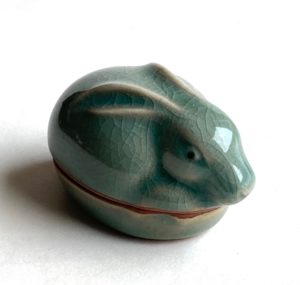
The next animal of the Asian zodiac following 2022 the year of the Tiger, is the year of the Hare / Rabbit: U-doshi, 卯年, Hare-year, which traditionally begins on January 22, 2023. It is the year of the Mizunoe U, 壬卯, Water ’s older brother Hare. The Kanji for the zodiac animal is u, 卯, wild hare, and the Kanji for the actual animal is usagi, 兎, hare, rabbit. When the Buddha died and attained nirvana, on the 15th day of the 2nd lunar month, the moon was full, rising in the east, as the sun was setting in the west, Amida’s paradise of Jō-do, 浄土, Pure-land, the Buddha’s spiritual destiny.
According to the kyū-reki, 旧暦, old-calendar, U-suki yō-ka, 卯月八日, Hare-month 8-day, is the date of Buddha’s birthday, Tan-jō-bi, 誕生日, Birth-live-day. The 8th day was a han-getsu, 半月, half-moon, just as Buddha’s enlightenment was on the 8th day of the lunar 12th month was a half-moon.
The Buddha attained enlightenment when he saw the rising of the morning star, Venus, which in Japanese is Myō-jō, 明星, Wisdom-star. It is interesting to note that the Kanji 明 meaning wisdom, bright, etc., is composed of nichi, 日, sun, and getsu, 月, moon. Wisdom is understanding the natures of the sun and the moon, On the 8th day, there would have been a han-getsu, 半月, half-moon. Half of the Kanji for wisdom, 明, is the moon, 月.
Buddha’s birth was on the 8th day of the 4th lunar month, and his enlightenment was on the 8th day of the 12th lunar month. Both days had half-moons. In the east, the markings on the moon look like a hare, rabbit, so that the hare may have some connection with the Buddha.
It is believed that a long time ago, the Buddha had lived the life of a rabbit, and had sacrificed his life to be roasted and eaten by a starving old man, who was Tai-shaku-ten, 帝釈天, Emperor-explain-heaven, king of the gods, in disguise. In gratitude, Taishakuten moved the appearance of the rabbit to the moon. The rabbit in the moon symbolizes Buddha’s compassion. The moon symbolizes wisdom, so the rabbit in the moon would represent compassion in wisdom.
![]()
The next animal of the Asian zodiac following 2023, the year of the Hare, is the year of the Dragon: Ki-no-e Tatsu, 甲辰, Wood’s older-brother Dragon, these Kanji are also read Kō-Shin, 甲辰, Shell-Vibrate. The lunar New Year begins on February 10, 2024.
